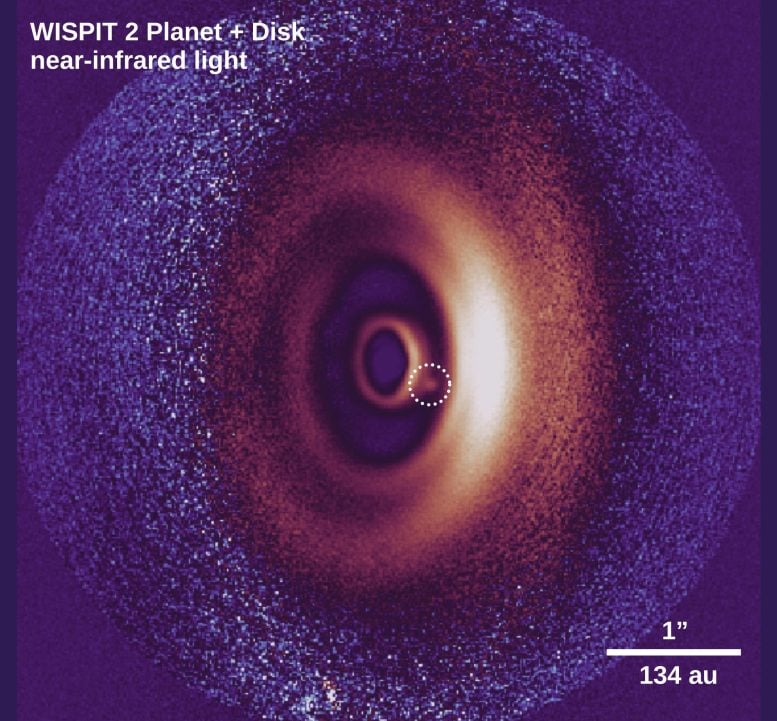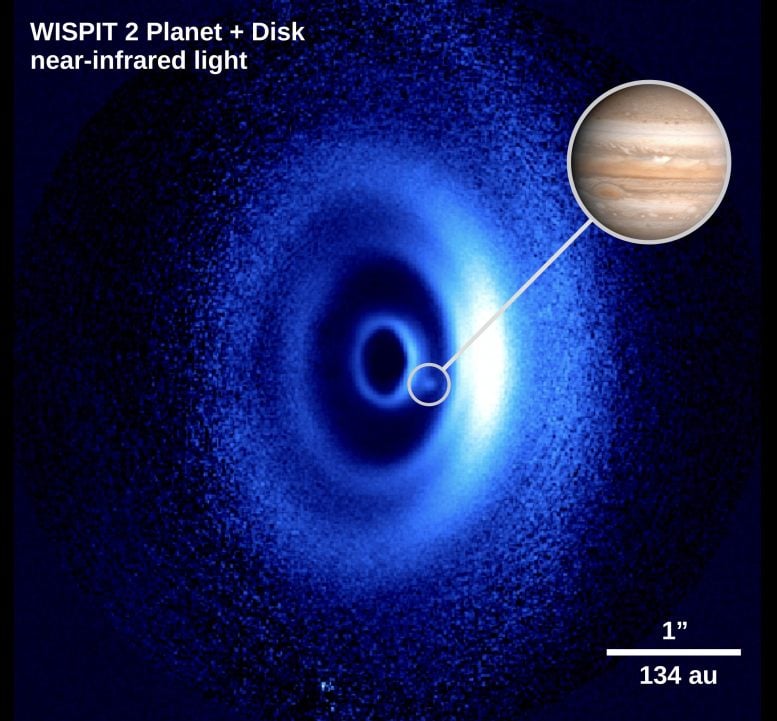
A young gas giant, WISPIT 2b, was detected within a multi-ringed disk around a Sun-like star. Its active formation provides a rare opportunity to study early planetary evolution.
An international team of astronomers, co-led by researchers from the University of Galway, has uncovered the surprising discovery of a previously unknown planet.
Found in its earliest stage of development around a young star similar to our Sun, the planet is estimated to be about 5 million years old and is likely a gas giant comparable in size to Jupiter.
The research, led by Leiden University in collaboration with the University of Galway and the University of Arizona, has been published in the journal Astrophysical Journal Letters.
This breakthrough was achieved using the European Southern Observatory’s Very Large Telescope (ESO’s VLT), one of the most advanced astronomical facilities in the world, located in Chile’s Atacama Desert.
To mark the publication of the study, the European Southern Observatory—widely regarded as the leading international astronomy organization—released a striking image of the discovery as its picture of the week.
The newly identified planet has been designated WISPIT 2b.

A multi-ringed dust disk
Dr. Christian Ginski, lecturer at the School of Natural Sciences, University of Galway, and second author of the study, said: “We used these really short snapshot observations of many young stars – only a few minutes per object – to determine if we could see a little dot of light next to them that is caused by a planet. However, in the case of this star, we instead detected a completely unexpected and exceptionally beautiful multi-ringed dust disk.
“When we saw this multi-ringed disk for the first time, we knew we had to try and see if we could detect a planet within it, so we quickly asked for follow-up observations.”
It is only the second time a confirmed planet has been detected at this early evolutionary stage around a young version of our Sun. The first one was discovered in 2018, by a research team also involving Dr. Ginski.
WISPIT 2b is also the first unambiguous planet detection in a multi-ringed disk, making it the ideal laboratory to study planet-disk interaction and subsequent evolution.

Planet glowing in infrared
The planet was captured in near infrared light – the type of view that someone would see when using night-vision goggles – as it is still glowing and hot after its initial formation phase.
The team at Leiden University and the University of Galway captured a spectacular, clear image of the young proto-planet embedded in a disk gap. They also confirmed that the planet is orbiting its host star.
The planet was also detected in visible light by a team from the University of Arizona using a specially designed instrument. This detection at a specific wavelength or color of light indicates that the planet is still actively accreting gas as it forms its atmosphere.
WISPIT 2b was detected as part of a five-year observational research project during which the international team sought to establish whether wide orbit gas giant planets are more common around younger or older stars. This led to the unexpected discovery of the new planet.
Dust and gas-rich disks around young stars are the birth cradles of planets. They can look quite spectacular with many different structures, such as rings and spiral arms, which researchers believe are related to planets forming within them. The disk around WISPIT 2b has a radius of 380 astronomical units – about 380 times the distance between Earth and the Sun.
Dr. Ginski added, “Capturing an image of these forming planets has proven extremely challenging, and it gives us a real chance to understand why the many thousands of older exoplanet systems out there look so diverse and so different from our own solar system. I think many of our colleagues who study planet formation will take a close look at this system in the years to come.”
References:
“WIde Separation Planets In Time (WISPIT): A Gap-clearing Planet in a Multi-ringed Disk around the Young Solar-type Star WISPIT 2” by Richelle F. van Capelleveen, Christian Ginski, Matthew A. Kenworthy, Jake Byrne, Chloe Lawlor, Dan McLachlan, Eric E. Mamajek, Tomas Stolker, Myriam Benisty, Alexander J. Bohn, Laird M. Close, Carsten Dominik, Sebastiaan Haffert, Rico Landman, Jie Ma, Ignas Snellen, Ryo Tazaki, Nienke van der Marel, Lukas Welzel and Yapeng Zhang, 26 August 2025, The Astrophysical Journal Letters.
DOI: 10.3847/2041-8213/adf721
Reference: “Wide Separation Planets in Time (WISPIT): Discovery of a Gap Hα Protoplanet WISPIT 2b with MagAO-X” by Laird M. Close, Richelle F. van Capelleveen, Gabriel Weible, Kevin Wagner, Sebastiaan Y. Haffert, Jared R. Males, Ilya Ilyin, Matthew A. Kenworthy, Jialin Li, Joseph D. Long, Steve Ertel, Christian Ginski, Alycia J. Weinberger, Kate Follette, Joshua Liberman, Katie Twitchell, Parker Johnson, Jay Kueny, Daniel Apai, Rene Doyon, Warren Foster, Victor Gasho, Kyle Van Gorkom, Olivier Guyon, Maggie Y. Kautz, Avalon McLeod, Eden McEwen, Logan Pearce, Lauren Schatz, Alexander D. Hedglen, Ya-Lin Wu, Jacob Isbell, Jenny Power, Jared Carlson, Emmeline Close, Elena Tonucci and Matthijs Mars, 26 August 2025, The Astrophysical Journal Letters.
DOI: 10.3847/2041-8213/adf7a5
Never miss a breakthrough: Join the SciTechDaily newsletter.
2 Comments
That enlargement of the Wispit 2 planet has a giant red spot uncommonly like that of Jupiter; fancy that!
And it has this in the caption:
This is an image of a new-born planet, likely a gas giant similar to Jupiter in our own solar system (comparison image given in upper right corner) but about 5 times more massive.